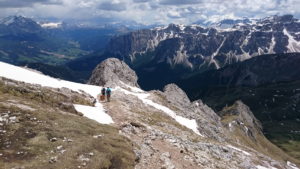Mountain climbing is no easy feat and is usually not recommended to hikers unless they’ve gotten some more experience.
But the reward can be quite spectacular, especially you are greeted by amazing views that you never thought could be possible, when you finally reach the summit.
But mountains aren’t safe or stable, and when you hike in one, you are coming in knowing full well the potential risk you are placing yourself in.
With all that said, the best thing you can do is reduce that risk by making sure that you don’t make these hiking mistakes.
Not keeping yourself fit
I hope you’ve been doing exercise recently; you’re definitely going to need it if you decide to go mountain hiking.
Mountain hiking is unlike most other hiking trails, as you will be climbing up a lot.
Think of it like climbing up the stairs of your house or a mall. Tiring, isn’t it?
Now imagine that, except you have to do it constantly and for hours.
Now pair that with all your clothes, uncomfortable weather, and all your equipment you’re hauling and you’re looking at a recipe for disaster if your body isn’t fit enough to handle the climb. A hike by itself already needs you to be fit, especially since you’ll be travelling for quite some time, but in a place such as a mountain, doubly so.
On the bright side, mountain hikes will also help give your body a lot of exercise, so if you’re already fit, you’ll feel even better when you get down.
Going up the mountain too fast
Altitude sickness is a very real problem for mountain hikers, but it can be avoided fairly easily as most mountain climbs don’t reach so high for the air to thin out so much and cause you to have breathing difficulties.
However, it can still be a problem for people who try to rush the climb. The peak isn’t going anywhere; what’s important is that you make it there safe and in one piece.
Even without the altitude difference problem you can get from high places, mountains are extremely unstable territory and can be very dangerous. Rushing in without a proper plan and not surveying the surroundings can lead to accidents or worse, death.
Bringing only junk food
Food is practically a given that you should bring in any hike, and any hiker worth their salt will tell you as such.
However, not just any type of food will do. Junk food like chips and instant noodles taste good and will fill you up, but your body needs more nutrients other than just those empty calories to keep chugging, especially when you still have a long mountain climb ahead of you.
Packing junk food isn’t bad, especially if you want a little pick-me up, but don’t make it your primary source of nourishment. At the very least, branch out and bring food that can give you the proper nourishment you need. Your body will thank you for it.
Not using sunscreen
On a normal day, the sun makes you feel good and bright thanks to the rays literally shining over you. On the beach, you want the sun to shine over you and give your body a tan.
But on the mountains? Unless you’re aiming to get skin cancer later on in life, forget about it. If the sunlight on other parts of the world, even other hiking trails like desert and forests make you sweat more and feel thirstier, sunlight on the mountains have the added danger of high UV that can be damaging to your skin.
A good climber understands this risk and places sunscreen everywhere, even the parts of his body that are sufficiently covered, just to play it safe.
After all, it’s not just the direct ray of sunlight that can hurt you. Places like the underside of your chin and ears that are normally covered by your clothes get struck straight on by the sun’s reflections on the snow.
Even panting can give your tongue sunburn and make the palate of your mouth quite painful. Do your body a favor and slather that sunscreen like you mean it.
Not drinking enough water
This is also a given in other hiking trails. In desert trails, for instance, you always want to keep drinking water even if you don’t feel thirsty. This is because while feeling thirsty is a sure sign of dehydration, that feeling doesn’t always occur, meaning that people have to constantly top themselves up to keep their water levels proper.
In mountain hiking, you will be doing a lot of climbing and burn through a lot of energy in the process. You will definitely start feeling thirsty constantly as you’ll be breathing heavily a lot. The continues trip also means that you should expect to sweat buckets on your trip, even if it’s chilly on the outside. It’s likely that your hiking boots will feel it on the inside.
The place isn’t as hot as a desert, but it’s no excuse to slack on your drinks. Make sure you bring a lot of water on your mountain hikes to avoid dehydration on the climb. The trip back down can be quite dangerous, so you don’t want to end up in such a perilous situation in the first place.
Wrapping up
Mountain hiking has its own fair share of risks, both on the mountain itself, and from human carelessness.
However, that doesn’t mean that mountain hiking should be completely avoided. If you have the proper know-hows and understanding of these risks and how to take care of yourself and your equipment on the trails while using common sense, you’ll find yourself reaching the peak sooner than you think.

